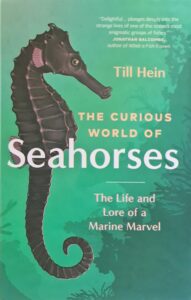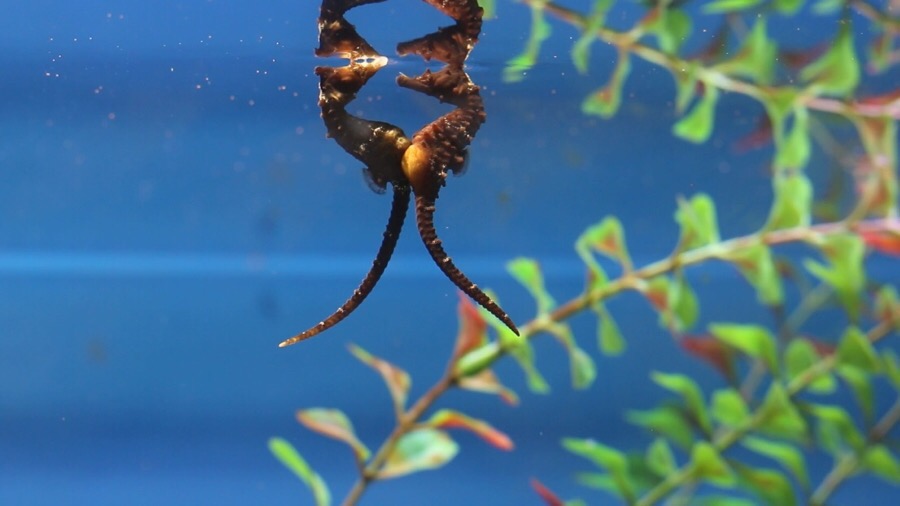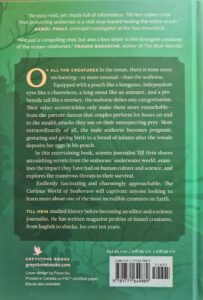Come on a journey with Till Hein and discover the secrets of the seahorse!
German science journalist Till Hein, a lover of fish, has written numerous masterpieces about finned creatures, from sharks to seahorses. This book takes you on an expedition to learn everything you need to know about these “horses of the sea.”
The book is well-structured, divided into chapters exploring various aspects of seahorses. You’ll meet scientists, hobbyists sharing their unique relationships with these fascinating creatures, and dive into topics like their origin, Greek mythology, life history, and unique adaptations. These adaptations include swimming upright, possessing a prehensile tail, and having fathers give birth! You’ll also discover why these bony fish are so endangered.
At the book’s beginning, you’re introduced to Elena Theys, the German “seahorse whisperer.” Despite living far from the ocean, she possesses an in-depth knowledge of successful seahorse husbandry. Captivated by these creatures upon encountering them at a pet shop, she dedicated herself to their care. Marine biologists from around the world seek her expertise in breeding strategies.
As their name suggests, seahorses have an equine (horse-like) appearance. They swim upright, possess a long, prehensile tail like monkeys, lack scales (instead having bony plates covered by skin), can rotate their eyes 360 degrees independently (like chameleons), have a tube-like snout with no teeth, are slow swimmers, and are compulsive eaters and vocal communicators.
How did these unique adaptations arise?
Seahorses are closely related to pipefish, which swim horizontally and share the Syngnathidae family. The earliest known seahorse fossils are two pipefish discovered in Slovenia, dating back 13 million years. Molecular dating suggests that seahorses diverged from pipefish due to tectonic shifts creating shallow waters with flourishing seagrass, prompting them to adopt an upright posture for camouflage.
One of the most fascinating aspects of seahorses is their male pregnancy. This phenomenon continues to puzzle scientists, but theories exist. One suggests that females, by not carrying eggs, can develop new ones while the male is gestating, allowing for more offspring within their short lifespan (2-5 years).
Another theory, proposed by Ralf Schneider, a marine ecologist and seahorse expert at GEOMAR interviewed in this book, suggests the male can provide additional nutrients like calcium and fatty acids. Additionally, the fluid inside the male’s brood pouch closely resembles the ocean environment, potentially reducing birth trauma compared to if the female carried the young. In this case, the female cannot provide these conditions as sufficiently.
Seahorse courtship involves a mesmerizing dance, resembling a heart shape from afar, with some reports of nose-rubbing and belly-bumping (see cover photo). The female then deposits her eggs into the male’s brood pouch through an “ovipositor” (a tube-like structure). After roughly 30 days (depending on the species), the male gives birth, releasing 100-2000 tiny fry (only about the size of a flea!). Sadly, only 1 in 200 survive to adulthood.
Though traditionally thought to be silent, it’s known that 50% of all fish communicate through sound. While visiting the fish laboratory of Friedrich Ladich, a bioacoustics expert at the University of Vienna, Till Hein learned about this fascinating behaviour. Ladich refers to seahorses as “chatterboxes”, producing sounds like quacks, whistles, buzzes, calls, peeps, and trills. They also communicate through skin colour changes, similar to chameleons and octopuses, earning them the nickname “rainbow creatures”.
As a marine educator who once mentioned “seahorse eating and pooping” to children (resulting in much giggling!), I can attest to their constant feeding behaviour. Seahorses, being agastric teleosts, lack a functional stomach, and digestion primarily occurs in the intestine.
There are around 46 seahorse species, and unfortunately, they face numerous threats like most marine life:
- Overfishing: They are overfished for Traditional Chinese Medicine (TCM) purposes, despite lacking scientific evidence to support claims of health benefits like improved sexual performance, labour induction, bedwetting control, or wheezing.
- Habitat Loss: Habitat loss due to degradation of seagrass beds, coral reefs, and mangroves, as well as bycatch, further endanger them.
This book serves as an excellent resource to learn about these fascinating creatures, understand their importance, and discover how we can protect them.
While I have only touched upon a few of the fascinating details Till Hein reveals, I hope this glimpse has inspired you to dive deeper into the captivating world of seahorses by reading his book.

Cover image: Mating behaviour of Korean seahorses (Hippocampus haema)
I have a master’s degree in marine biology, ecology, and behavioural biology obtained from the University of Vienna. Since I can remember I wanted to become a marine biologist, despite growing up in a country without an ocean, but I guess my South African roots just kept on pushing to make this dream come true. After graduation I spent a year in Australia and assisted several NGOs with marine educational talks and citizen science programmes. Here I had the privilege of observing humpback whales on their annual migration passed the eastern coast of Australia, and participating in seagrass and rockpool monitoring activities. With a heavy heart I left Australia, but soon after obtained a position as a marine educator at Malta National Aquarium. Today I am based in Germany exploring marine critters in the North and Baltic Sea and if I am not too busy, you’ll find me diving in the Red Sea, blogging on my Facebook page, swimming, running, reading, and meditating.


